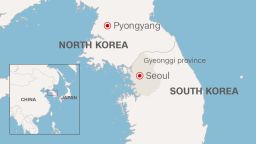Story highlights
Kim Jong Un presided over an emergency military meeting late Thursday, state media say
"North Korea has more to gain from conflict theater than from a conflict," an analyst says
North Korea has threatened to blow up South Korean propaganda loudspeakers at the border
North Korean leader Kim Jong Un has ordered front-line military units to enter “a wartime state” after an exchange of fire with South Korea, his country’s state-run Korean Central News Agency reported Friday.
The announcement, employing bellicose language typical of North Korea, adds to the edgy situation in the region.
The two sides traded artillery fire over their heavily fortified border on Thursday afternoon, according to the South Korean Defense Ministry.
Two shells came from the North Korean side, the ministry said, and South Korea fired dozens of shells in response.
No casualties were reported from the exchange of fire.

North Korea hasn’t given a detailed account of events, but the KCNA report Friday accused South Korea of committing a “military provocation.”
Kim presided over an emergency meeting of the North’s Central Military Commission late Thursday, issuing an order that the army’s “front-line large combined units” should “enter a wartime state to be fully battle ready to launch surprise operations,” KCNA said.
He also ordered that “the area along the front be put in a semi-war state,” according to the report. The measures are to take effect from 5 p.m. Friday local time.
Theatrical conflict?
It’s hardly the first time North Korea has used such alarming language.
During a period of heightened tensions in the region in 2013, North Korea announced it had entered “a state of war” with South Korea. That situation didn’t result in military clashes.
Jamie Metzl, an Asia expert for the Atlantic Council in New York, said he thought it was unlikely that the current crisis would escalate further.
“North Korea has more to gain from conflict theater than from a conflict that would quickly expose its fundamental weakness,” he said.
South Korea, a key U.S. ally where roughly 28,000 American troops are based, said it’s on high alert after the exchange of fire.
The Pentagon is also monitoring the situation closely, said Cmdr. William Urban, a Defense Department spokesman.
Tensions spiked on the Korean Peninsula after two South Korean soldiers were seriously wounded by landmines on August 4 in the demilitarized zone that separates the two countries.
South Korea has accused the North of deliberately planting the mines, an allegation that Pyongyang denies.
North Korean threats over loudspeakers
Seoul vowed a “harsh” response to the landmines and resumed blaring propaganda messages over the border from huge loudspeakers last week.
The move infuriated North Korea, which called the broadcasting “a direct action of declaring a war.” Over the weekend, it threatened to blow up the South Korean speakers and also warned of “indiscriminate strikes.”
A U.S. official told CNN that the United States believes that North Korea fired at a South Korean loudspeaker on Thursday.
South Korea said that North Korea sent a written message around 5 p.m. Thursday local time threatening military action if Seoul doesn’t stop the propaganda broadcasts within 48 hours and remove the loudspeakers.
A South Korean Defense Ministry official warned Friday that Seoul would retaliate strongly to any additional North Korean provocations.
On Monday, North Korea pumped its own propaganda broadcasts over the border, the same day South Korea started military exercises with the United States and other countries. Pyongyang says it views the drills as a prelude to an invasion.
The North Korean government asked this week that the exercises, which it described as “serious provocations” be placed on the U.N. Security Council’s agenda. Pyongyang has made similar requests before without success.
A history of clashes
While the current tensions on the Korean Peninsula are unsettling, they’re not without precedent.
In November 2010, North Korea shelled an island near the countries’ disputed maritime border, killing two South Korean marines.
The two sides also traded fire in October 2014. A clash took place between patrol boats in the Yellow Sea, and then another flared days later over land after North Korean gunners apparently targeted balloons carrying leaflets critical of the country’s reclusive regime.
Over the past six decades, skirmishes have flared repeatedly along land and sea borders as each state aims to reunify the peninsula according to its own terms and system of government. Deadly naval clashes occurred along the demarcation line in 1999, 2002 and 2009.
Following Japan’s defeat in World War II, Korea became a divided nation – the capitalist South supported by the United States and its Western allies, and the communist North an ally of the Soviet Union.
Cold War tensions erupted into war in 1950, devastating the peninsula and taking the lives of as many as 2 million people. The fighting ended in 1953 with a truce, not a treaty, and settled little.
Technically, the two Koreas are still at war.
Besides the border skirmishes, other incidents have proved provocative. In 1968, North Korea dispatched commandos in an unsuccessful attempt to assassinate South Korea’s President. In 1983, a bombing linked to Pyongyang killed 17 high-level South Korean officials on a visit to Myanmar. In 1987, the North was accused of bombing a South Korean airliner.
CNN’s Barbara Starr, Brian Todd, Greg Botelho, Kathy Novak and Don Melvin, and journalist Jungeun Kim contributed to this report.






















